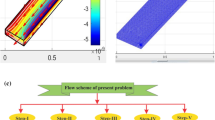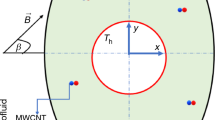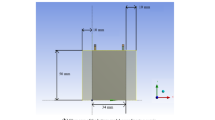Abstract
In this study, an advanced cooling method for microelectronic modules in a magnetic field is examined through a numerical and artificial intelligence approach. The research utilized a serpentine microchannel with a rectangular cross section and a laminar and steady flow, assessing various flow rates ranging from 0.01 to 0.1 mL s−1. A hybrid nanofluid made of soybean oil with MgO and Al2O3 nanoparticles served as the coolant, tested at different mixing ratios and volume fractions of 1–4%. The impact of several parameters, including forced convection, magnetic field intensity (0–1 Tesla), module heating capacity (3–7 W), and aspect ratio of the microchannel section (AR) (0.5, 1, and 2), was explored using computational fluid dynamics. The research findings revealed that a 1 Tesla magnetic field notably increased module temperatures, with the maximum cooling efficiency observed with the application of the hybrid nanofluid, optimized convection, an AR of 0.5, and the inclusion of a magnetic insulator. This optimal setup resulted in a significant temperature reduction ranging from 5.98 to 112.88 K compared to the use of pure soybean oil without forced convection and a magnetic field strength of 1 Tesla. Furthermore, the study integrated an artificial neural network (ANN) model, which demonstrated superior accuracy and reliability in predicting the system's performance compared to genetic algorithm models. The effectiveness of ANN as a predictive tool suggests a reduction in dependency on elaborate physical experiments for evaluating the cooling performance of microelectronic modules under magnetic influence. This research proposes a potent and systematic approach for managing the thermal challenges faced by microelectronic devices in magnetic fields and deems further exploration into hybrid ANN models with meta-heuristic algorithms beneficial for enhancing solar collector modeling.






























Similar content being viewed by others
Abbreviations
- A :
-
Area of the upper surface, m2
- AR:
-
Aspect ratio
- B :
-
Magnetic field strength, T
- C p :
-
Specific heat capacity, J kg−1K−1
- D s :
-
Hydraulic diameter, m
- E :
-
External electric field, V m−1
- f :
-
Friction factor
- F :
-
Lorentz force, N
- H :
-
Height, m
- h :
-
Convective heat transfer coefficient, W m−2K−1
- J :
-
Electric current density, A m−2
- K :
-
Thermal conductivity, W m−1K−1
- Nu:
-
Nusselt number
- P :
-
Pressure, Pa
- PEC:
-
Thermal–hydraulic performance coefficient
- Q :
-
Heat capacity, W
- T :
-
Temperature, K
- u :
-
Velocity components, m s−1
- U :
-
Velocity field, m s−1
- W :
-
Width, m
- μ :
-
Dynamic viscosity, Pa s
- \(\vartheta\) :
-
Kinematic viscosity, m2 s−1
- ρ :
-
Density, kg m−3
- σ :
-
Electrical conductivity, S m−1
- φ :
-
Volume fraction (%)
- avg:
-
Average
- f :
-
Base fluid (i.e., soybean oil)
- hnf:
-
Hybrid nanofluid
- hp:
-
Hybrid nanoparticles
- s :
-
Serpentine microchannel section
- w :
-
Microchannel wall
- AR:
-
Aspect ratio
- CFD T:
-
Computational fluid dynamics Tesla
References
AVIP U. Air Force Avionics Integrity Program. Notes. 1989.
Yeh LT, Chu RC, Janna WS. Thermal management of microelectronic equipment: heat transfer theory, analysis methods, and design practices. ASME press book series on electronic packaging. Appl Mech Rev. 2003;56:B46-48. https://doi.org/10.1115/1.1566408.
Levin ML, Miller MA, Maxwell’s “treatise on electricity and magnetism.” Soviet Physics - Uspekhi. 1981; https://doi.org/10.1070/PU1981v024n11ABEH004793
Shah RK, Khandekar S. Exploring ferrofluids for heat transfer augmentation. J Magn Magn Mater. 2019. https://doi.org/10.1016/j.jmmm.2018.11.034.
Younes H, Mao M, Sohel Murshed SM, Lou D, Hong H, Peterson GP. Nanofluids: key parameters to enhance thermal conductivity and its applications. Appl Therm Eng. 2022. https://doi.org/10.1016/j.applthermaleng.2022.118202.
Keerthi ML, Gireesha BJ, Sowmya G. Impact of shape-dependent hybrid nanofluid on transient efficiency of a fully wet porous longitudinal fin. Arab J Sci Eng. 2023;11:1.
Azadi M, Hosseinirad E, Hormozi F, Rashidi S. Second law analysis for nanofluid flow in mini-channel heat sink with finned surface: a study on fin geometries. J Therm Anal Calorim. 2020;140:1883–95.
Naderifar A, Nikian M, Javaherdeh K, Borji M. Numerical investigation of the effect of fins on heat transfer enhancement of a laminar non-Newtonian nanofluid flow through a corrugated channel. J Therm Anal Calorim. 2022;147:9779–91.
Farahani SD, Alibeigi M, Zakinia A, Goodarzi M. The effect of microchannel-porous media and nanofluid on temperature and performance of CPV system. J Therm Anal Calorim. 2022;147:7945–60.
Montazerifar F, Amidpour M, Abedi Z. Numerical investigation of turbulent nanofluid flow behavior in a multi-stream plate-fin heat exchanger with a novel design of fractal fins. Alex Eng J. 2023. https://doi.org/10.1016/j.aej.2023.03.090.
Cacua K, Murshed SMS, Pabón E, Buitrago R. Retraction Note: Dispersion and thermal conductivity of TiO2/water nanofluid: Effects of ultrasonication, agitation and temperature. J Therm Anal Calorim. 2020;140:109–14.
Mehrpooya M, Tabatabaei SH, Pourfayaz F, Ghorbani B. High-temperature hydrogen production by solar thermochemical reactors, metal interfaces, and nanofluid cooling. J Therm Anal Calorim. 2021;145:2547–69.
Alharbi SO. Influence of wall slip and jump in wall temperature on transport of heat energy in hybrid nanofluid. J Therm Anal Calorim. 2021;144:847–54.
Nayebpashaee N, Hadavi SMM. Thermal conductivity and surface tension of graphene–Al2O3/ethylene glycol–water hybrid nanofluid at sub-zero temperatures: an experimental study. J Therm Anal Calorim. 2022;147:13039–57.
Li H, Zuo X, Zhang D, Yin H, Yan H, Yang W, et al. Experimental and numerical investigation of flow and heat transfer characteristics of Chinese ink nanofluid in built-in rotor tube. Int J Therm Sci. 2023. https://doi.org/10.1016/j.ijthermalsci.2022.108115.
Bhatti MM, Marin M, Ellahi R, Fudulu IM. Insight into the dynamics of EMHD hybrid nanofluid (ZnO/CuO-SA) flow through a pipe for geothermal energy applications. J Therm Anal Calorim. 2023;148:14261–73.
Sindhu S, Gireesha BJ. Entropy generation analysis of hybrid nanofluid in a microchannel with slip flow, convective boundary and nonlinear heat flux. Int J Numer Methods Heat Fluid Flow. 2021;31:53–74.
Manjunatha S, Puneeth V, Anandika R, Gireesha BJ. Analysis of multilayer convective flow of a hybrid nanofluid in porous medium sandwiched between the layers of nanofluid. Heat Transf. 2021. https://doi.org/10.1002/htj.22292.
Mahanthesh B, Gireesha BJ, Athira PR. Radiated flow of chemically reacting nanoliquid with an induced magnetic field across a permeable vertical plate. Results Phys. 2017. https://doi.org/10.1016/j.rinp.2017.07.010.
Ho CJ, Peng JK, Yang TF, Rashidi S, Yan WM. Comparison of cooling performance of nanofluid flows in mini/micro-channel stacked double-layer heat sink and single-layer micro-channel heat sink. Int J Therm Sci. 2023. https://doi.org/10.1016/j.ijthermalsci.2023.108375.
Krishna VM, Kumar MS, Muthalagu R, Kumar PS, Mounika R. Numerical study of fluid flow and heat transfer for flow of Cu-Al2O3-water hybrid nanofluid in a microchannel heat sink. Mater Today Proc. 2022. https://doi.org/10.1016/j.matpr.2021.06.385.
Vinoth R, Sachuthananthan B. Flow and heat transfer behavior of hybrid nanofluid through microchannel with two different channels. Int Commun Heat Mass Transf. 2021. https://doi.org/10.1016/j.icheatmasstransfer.2021.105194.
Selimefendigil F, El-Sinawi AH, Oztop HF. Optimization of bifurcating channel cooling system for double inclined conductive panel system under inclined magnetic field. Int J Therm Sci. 2023. https://doi.org/10.1016/j.ijthermalsci.2023.108358.
Sundar LS, Ramana EV. Influence of magnetic field location on the heat transfer and friction factor of CoFe2O4-BaTiO3/EG hybrid nanofluids in laminar flow: An experimental study. J Magn Magn Mater. 2023. https://doi.org/10.1016/j.jmmm.2023.170837.
Kai Y, Ali K, Ahmad S, Ahmad S, Jamshed W, Raizah Z, et al. A case study of different magnetic strength fields and thermal energy effects in vortex generation of Ag-TiO2 hybrid nanofluid flow. Case Stud Therm Eng. 2023. https://doi.org/10.1016/j.csite.2023.103115.
Bhattacharyya S, Sharma AK, Vishwakarma DK, Saini K, Paul AR, Huan Z. Thermo-hydraulic performance of magnetic baffles for cooling using magnetic nanofluid in a mini channel. Sustain Energy Technol Assess. 2023. https://doi.org/10.1016/j.seta.2023.103194.
Jalili B, Rezaeian A, Jalili P, Ommi F, Domiri GD. Numerical modeling of magnetic field impact on the thermal behavior of a microchannel heat sink. Case Stud Therm Eng. 2023. https://doi.org/10.1016/j.csite.2023.102944.
Purusothaman A, Malekshah EH. Lattice Boltzmann modeling of MHD free convection of nanofluid in a V-shaped microelectronic module. Therm Sci Eng Prog. 2019. https://doi.org/10.1016/j.tsep.2019.01.019.
Liu Z, Li H, Liu K, Yu H, Cheng K. Design of high-performance water-in-glass evacuated tube solar water heaters by a high-throughput screening based on machine learning: a combined modeling and experimental study. Sol Energy. 2017. https://doi.org/10.1016/j.solener.2016.12.015.
Yılmaz İH, Mwesigye A. Modeling, simulation and performance analysis of parabolic trough solar collectors: a comprehensive review. Appl Energy Elsevier Ltd. 2018. https://doi.org/10.1016/j.apenergy.2018.05.014.
Ebrahimi-Moghadam A, Mohseni-Gharyehsafa B, Farzaneh-Gord M. Using artificial neural network and quadratic algorithm for minimizing entropy generation of Al2O3-EG/W nanofluid flow inside parabolic trough solar collector. Renew Energy. 2018. https://doi.org/10.1016/j.renene.2018.06.023.
Tawalbeh M, Mohammed S, Alnaqbi A, Alshehhi S, Al-Othman A. Analysis for hybrid photovoltaic/solar chimney seawater desalination plant: A CFD simulation in Sharjah. United Arab Emirates Renew Energy. 2023. https://doi.org/10.1016/j.renene.2022.11.106.
Parrales A, Reyes-Téllez ED, Ajbar W, Hernández JA. Artificial neural network applied to the renewable energy system performance. Artif Neural Networks for Renewable Energy Systems and Real-World Applications. 2022. https://doi.org/10.1016/B978-0-12-820793-2.00006-9.
El Mghouchi Y. Solar energy modelling and forecasting using artificial neural networks: a review, a case study, and applications. Artif Neural Net Renew Energy Syst and Real-World Appl. 2022. https://doi.org/10.1016/B978-0-12-820793-2.00009-4.
Vakili M, Sabbagh-Yazdi SR, Khosrojerdi S, Kalhor K. Evaluating the effect of particulate matter pollution on estimation of daily global solar radiation using artificial neural network modeling based on meteorological data. J Clean Prod. 2017. https://doi.org/10.1016/j.jclepro.2016.09.145.
Kumar MS, Vasu V, Gopal AV. Thermal conductivity and rheological studies for Cu–Zn hybrid nanofluids with various basefluids. J Taiwan Inst Chem Eng. 2016. https://doi.org/10.1016/j.jtice.2016.05.033.
Kumar S, Kothiyal AD, Bisht MS, Kumar A. Turbulent heat transfer and nanofluid flow in a protruded ribbed square passage. Results Phys. 2017. https://doi.org/10.1016/j.rinp.2017.09.023.
Job VM, Gunakala SR. Mixed convection nanofluid flows through a grooved channel with internal heat generating solid cylinders in the presence of an applied magnetic field. Int J Heat Mass Transf. 2017. https://doi.org/10.1016/j.ijheatmasstransfer.2016.11.021.
Parsaiemehr M, Pourfattah F, Akbari OA, Toghraie D, Sheikhzadeh G. Turbulent flow and heat transfer of Water/Al2O3 nanofluid inside a rectangular ribbed channel. Physica E Low Dimens Syst Nanostruct. 2018. https://doi.org/10.1016/j.physe.2017.10.012.
Valiallah Mousavi S, Gerdroodbary MB, Sheikholeslami M, Ganji DD. The influence of a magnetic field on the heat transfer of a magnetic nanofluid in a sinusoidal channel. Eur Phys J Plus. 2016. https://doi.org/10.1140/epjp/i2016-16347-4.
Brinkman HC. The viscosity of concentrated suspensions and solutions. J Chem Phys. 1952. https://doi.org/10.1063/1.1700493.
James Clerk M. A treatise on electricity and magnetism. A Treatise on Electricity and Magnetism [Internet]. 2010 [cited 2024 Jan 6]; 9781108014038:1–442. Available from: https://www.cambridge.org/core/books/treatise-on-electricity-and-magnetism/130A7181ECAB0C990FBC2B88341A4141
Hoffmann JF, Henry JF, Vaitilingom G, Olives R, Chirtoc M, Caron D, et al. Temperature dependence of thermal conductivity of vegetable oils for use in concentrated solar power plants, measured by 3omega hot wire method. Int J Therm Sci. 2016. https://doi.org/10.1016/j.ijthermalsci.2016.04.002.
Esteban B, Riba JR, Baquero G, Rius A, Puig R. Temperature dependence of density and viscosity of vegetable oils. Biomass Bioenergy. 2012. https://doi.org/10.1016/j.biombioe.2012.03.007.
Li C, Huang J, Shang Y, Huang H. Study on the flow and heat dissipation of water-based alumina nanofluids in microchannels. Case Stud Therm Eng. 2020. https://doi.org/10.1016/j.csite.2020.100746.
Li P, Zhang D, Xie Y. Heat transfer and flow analysis of Al2O3–water nanofluids in microchannel with dimple and protrusion. Int J Heat Mass Transf. 2014. https://doi.org/10.1016/j.ijheatmasstransfer.2014.02.042.
Pordanjani AH, Vahedi SM, Aghakhani S, Afrand M, Öztop HF, Abu-Hamdeh N. Effect of magnetic field on mixed convection and entropy generation of hybrid nanofluid in an inclined enclosure: sensitivity analysis and optimization. Eur Phys J Plus. 2019;134:1–20.
Davarnejad R, Jamshidzadeh M. CFD modeling of heat transfer performance of MgO-water nanofluid under turbulent flow. Eng Sci Technol Int J. 2015. https://doi.org/10.1016/j.jestch.2015.03.011.
Hatami N, Kazemnejad Banari A, Malekzadeh A, Pouranfard AR. The effect of magnetic field on nanofluids heat transfer through a uniformly heated horizontal tube. Phys Lett A. 2017. https://doi.org/10.1016/j.physleta.2016.12.017.
Sharadga H, Hajimirza S, Balog RS. Time series forecasting of solar power generation for large-scale photovoltaic plants. Renew Energy. 2020. https://doi.org/10.1016/j.renene.2019.12.131.
Shafieian A, Parastvand H, Khiadani M. Comparative and performative investigation of various data-based and conventional theoretical methods for modelling heat pipe solar collectors. Sol Energy. 2020. https://doi.org/10.1016/j.solener.2020.01.056.
Alade IO, Abd Rahman MA, Abbas Z, Yaakob Y, Saleh TA. Application of support vector regression and artificial neural network for prediction of specific heat capacity of aqueous nanofluids of copper oxide. Sol Energy. 2020. https://doi.org/10.1016/j.solener.2019.12.067.
Correa-Jullian C, Cardemil JM, López Droguett E, Behzad M. Assessment of deep learning techniques for prognosis of solar thermal systems. Renew Energy. 2020. https://doi.org/10.1016/j.renene.2019.07.100.
Vakili M, Karami M, Delfani S, Khosrojerdi S. Experimental investigation and modeling of thermal radiative properties of f-CNTs nanofluid by artificial neural network with Levenberg–Marquardt algorithm. Int Commun Heat Mass Transf. 2016. https://doi.org/10.1016/j.icheatmasstransfer.2016.09.011.
Murshed SS, De Castro CN. A critical review of traditional and emerging techniques and fluids for electronics cooling. Renew Sustain Energy Rev. 2017. https://doi.org/10.1016/j.rser.2017.04.112.
Funding
We have not received any funds.
Author information
Authors and Affiliations
Corresponding author
Ethics declarations
Conflict of interest
All authors declare that they have no conflicts of interest.
Additional information
Publisher's Note
Springer Nature remains neutral with regard to jurisdictional claims in published maps and institutional affiliations.
Rights and permissions
Springer Nature or its licensor (e.g. a society or other partner) holds exclusive rights to this article under a publishing agreement with the author(s) or other rightsholder(s); author self-archiving of the accepted manuscript version of this article is solely governed by the terms of such publishing agreement and applicable law.
About this article
Cite this article
Salehin, A., Mirabdolah Lavasani, A., Nimafar, M. et al. Optimizing microelectronic module cooling under magnetic fields through hybrid nanofluid: a computational fluid dynamics-artificial neural network approach. J Therm Anal Calorim (2024). https://doi.org/10.1007/s10973-024-13123-6
Received:
Accepted:
Published:
DOI: https://doi.org/10.1007/s10973-024-13123-6




